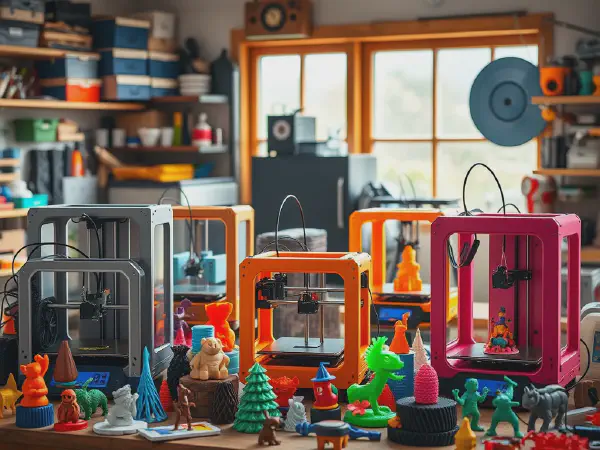Best Beginner 3D Printers: Your Guide to Getting Started

The Fascinating World of 3D Printing
3D printing, also known as additive manufacturing, is a revolutionary technology that has transformed various industries. It allows you to create three-dimensional objects by layering materials based on a digital design. The process involves a printer that deposits layers of material, such as plastic, metal, or even biocompatible materials, to build the object. From prototypes to functional parts, 3D printing offers endless possibilities.
One of the key advantages of 3D printing is its ability to create complex geometries that traditional manufacturing methods struggle with. It eliminates the need for molds or tooling, reducing costs and lead times. Additionally, 3D printing enables customization and personalization, giving individuals the freedom to create unique products tailored to their specific needs.
The applications of 3D printing are extensive. In the medical field, it is used to fabricate prosthetics, dental implants, and anatomical models for surgical planning. Architects and product designers utilize 3D printing to create intricate models and prototypes. The automotive and aerospace industries leverage this technology to manufacture lightweight components with complex geometries, improving performance and fuel efficiency.
As the technology continues to advance, there are different types of 3D printers available in the market. Each type utilizes a different printing technique and material to achieve the desired output. Common types include FDM (Fused Deposition Modeling), SLA (Stereolithography Apparatus), and DLP (Digital Light Processing) printers.
If you're new to 3D printing, starting with the best beginner 3d printer can greatly enhance your learning experience.
When considering a 3D printer, there are several important features to consider. These include build volume, print resolution, and filament compatibility. Build volume refers to the maximum size of the object that can be printed. Print resolution determines the level of detail and precision of the printed object. Filament compatibility determines the type of materials that can be used in the printer.
Types of 3D Printers:
FDM printers, also known as filament printers, are the most common and affordable type of 3D printer. They work by melting a plastic filament and depositing it layer by layer to create the object. FDM printers are ideal for beginners and are widely used for prototyping, hobby projects, and functional parts.
SLA printers use a liquid resin that is cured by a UV light source layer by layer. This results in high-quality, detailed prints with a smooth surface finish. SLA printers are commonly used in industries such as jewelry, dentistry, and product design where precision and aesthetics are crucial.
DLP printers are similar to SLA printers but use a digital light projector to cure the resin. This allows for faster printing speeds and higher resolution. DLP printers are commonly used in the dental field to create accurate dental models and orthodontic appliances.
Features to Consider:
Build volume is an important consideration, as it determines the size of the objects you can print. Larger build volumes allow for the creation of bigger prototypes or multiple smaller objects in a single print. It is important to choose a printer with a build volume that suits your needs.
Print resolution refers to the level of detail and precision that can be achieved in the printed object. Higher resolution printers can produce objects with finer details and smoother surfaces. This is important if you require highly accurate and intricate prints.
Filament compatibility refers to the types of materials that can be used in the 3D printer. Some printers are limited to specific types of filaments, such as PLA or ABS, while others have a wider range of options. Consider the materials you plan to work with and ensure the printer is compatible.
Top Beginner 3D Printers:
Prusa i3 MK3S is a popular choice among beginners due to its reliability and ease of use. It offers a large build volume of 250mm x 210mm x 200mm and has a high print resolution of 50 microns. The Prusa i3 MK3S supports various filament types and has a user-friendly interface.
Creality Ender 3 is another great option for beginners on a budget. It has a decent build volume of 220mm x 220mm x 250mm and a print resolution of up to 100 microns. The Ender 3 is known for its stability and ability to produce quality prints.
Anycubic i3 Mega is a user-friendly 3D printer that offers a large build volume of 210mm x 210mm x 205mm. It has a print resolution of up to 50 microns and supports a wide range of filament materials. The i3 Mega is known for its reliability and affordability.
Setting Up Your 3D Printer:
When setting up your 3D printer, choose a location that provides adequate space for the printer and allows for proper ventilation. It is important to have a stable surface and access to power outlets.
Calibrating the printer is crucial for achieving accurate prints. Follow the manufacturer's instructions to level the build plate and calibrate the extruder. This will ensure the printer is properly aligned and ready for printing.
Installing the necessary software is essential for controlling and managing your 3D printer. Most printers come with their own software or are compatible with open-source software like Cura or PrusaSlicer. Install the software and configure the printer settings according to your needs.
Printing Tips:
Choosing the right filament is important for achieving the desired properties in your prints. PLA is a commonly used filament that is easy to work with and offers good strength and print quality. ABS is more durable but requires a heated bed for printing.
Adjusting print settings such as temperature, layer height, and print speed can greatly impact the quality of your prints. Experiment with different settings to find the optimal combination for your specific project.
Troubleshooting common issues is part of the 3D printing process. Issues like warping, layer shifting, or poor adhesion can occur. Educate yourself on troubleshooting techniques and learn from experience to overcome these challenges.
